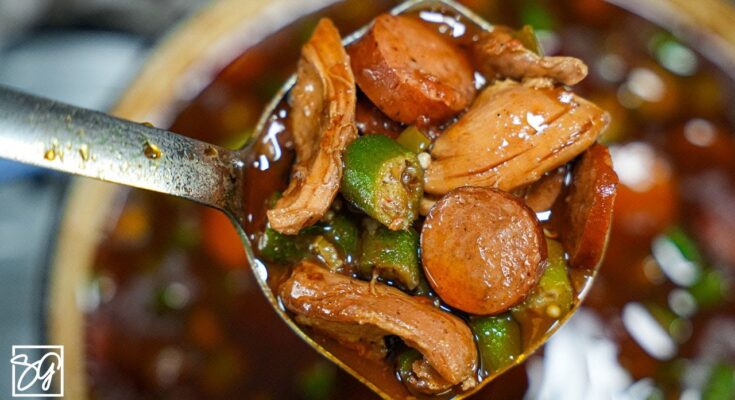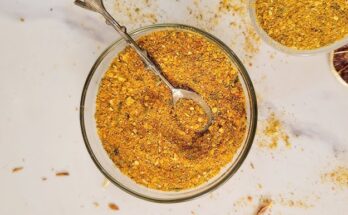Cajun Gumbo Recipe: If there’s one dish that defines the heart and soul of Louisiana cuisine, it’s gumbo. This rich, flavorful stew combines a bold blend of ingredients like meats, seafood, vegetables, and spices to create something truly magical. Whether you’ve tasted gumbo before or you’re entirely new to it, this guide will walk you through every step of the process to make authentic Cajun gumbo from scratch.
Not only is gumbo a comfort food, but it’s also a symbol of Louisiana’s diverse cultural heritage, with French, African, and Native American influences shaping its evolution. Ready to dive into a world of flavor? Let’s get started!
Ingredients for Cajun Gumbo
To make the perfect gumbo, you’ll need the following key ingredients:
Essential Ingredients:
- 1 cup vegetable oil
- 1 cup all-purpose flour
- 1 large onion, chopped
- 1 green bell pepper, chopped
- 2 celery stalks, chopped
- 1 pound smoked andouille sausage, sliced
- 1 pound chicken thighs, boneless and skinless
- 4 cups chicken stock or seafood stock
- 1 pound raw shrimp (optional)
- 2 teaspoons Cajun seasoning
- 1 teaspoon smoked paprika
- Salt and black pepper to taste
- 2 tablespoons filé powder (optional, for thickening)
- 4 cups cooked white rice
Substitutions:
- You can swap chicken for turkey or duck.
- Andouille sausage can be replaced with any smoked sausage.
- For a seafood gumbo, add crab, oysters, or crawfish.
Make sure to gather all your ingredients before starting. Having everything prepped will save time and help you stay organized.
Step 1: Preparing the Roux
A good roux is the foundation of gumbo. It’s a mixture of flour and fat (in this case, oil) that’s cooked until it reaches a deep, rich brown color. This adds depth and richness to your gumbo.
How to Make the Roux:
- Heat 1 cup of oil in a large pot over medium heat.
- Gradually whisk in 1 cup of flour until smooth.
- Continue to stir constantly. The mixture will darken over time—aim for a deep chocolate brown color.
Pro Tip: Stir constantly! Roux can burn quickly, and once it does, you’ll have to start over. Be patient—this step can take 20-30 minutes, but it’s worth it.
Step 2: Adding the Holy Trinity (Onion, Bell Pepper, Celery)
Once your roux is ready, it’s time to add the “Holy Trinity” of Cajun cooking—onion, bell pepper, and celery. These three vegetables form the aromatic base of many Cajun and Creole dishes.
Steps:
- Add the chopped onions, bell peppers, and celery to the hot roux.
- Stir well and sauté for about 5-7 minutes until the vegetables are softened and fragrant.
- Lower the heat slightly if needed to prevent burning.
This combination infuses the roux with a savory, aromatic flavor that sets the stage for the rest of the dish.
Step 3: Adding Sausage and Chicken (or Other Protein Options)
Next, it’s time to incorporate the proteins. Andouille sausage and chicken are the classic choices for Cajun gumbo.
How to Prepare the Proteins:
- In a separate pan, brown the sliced andouille sausage until lightly crisped, then add it to the pot.
- Sear the chicken thighs until golden brown on both sides. Cut into chunks and add to the gumbo pot.
Protein Variations:
- For a seafood gumbo, you can skip the chicken and sausage, adding shrimp, crab, or oysters later in the process.
- Vegetarian? Use plant-based sausage or mushrooms as a hearty alternative.
The proteins will add savory richness and depth to your gumbo.
Step 4: Seasoning the Gumbo
Seasoning is key to capturing that authentic Cajun flavor. The right balance of spices will elevate your gumbo to restaurant-quality.
Essential Seasonings:
- 2 teaspoons Cajun seasoning
- 1 teaspoon smoked paprika
- 1 teaspoon garlic powder
- ½ teaspoon cayenne pepper (optional, for heat)
- Salt and black pepper to taste
Steps:
- Sprinkle the seasonings over the vegetables and proteins in the pot.
- Stir everything well to coat the ingredients evenly.
- Taste and adjust seasoning as needed.
Avoid over-seasoning at this stage. You can always add more later once the gumbo has simmered.
Step 5: Adding Broth and Thickening the Gumbo
Once the proteins and seasonings are combined, it’s time to add the liquid base.
Steps:
- Pour in 4 cups of chicken or seafood stock. Stir to combine with the roux mixture.
- Bring the gumbo to a gentle simmer.
- Add okra (optional) for a natural thickener or use filé powder at the end of cooking.
Simmering allows the flavors to meld beautifully. You’ll want to let the gumbo cook for at least an hour to reach its full potential.
Step 6: Adding Seafood (Optional)
Seafood is a popular addition to Cajun gumbo, particularly in coastal regions of Louisiana. Shrimp, crab, crawfish, and oysters are commonly used to give the dish a fresh, briny flavor.
How to Add Seafood:
- Once your gumbo has simmered for about an hour, add peeled and deveined shrimp to the pot.
- If using crab or crawfish, add them at the same time as the shrimp.
- Oysters should be added in the final 5-10 minutes to prevent overcooking.
Tips:
- Seafood cooks quickly, so keep an eye on it. Overcooked shrimp can become rubbery.
- If you’re making a seafood-only gumbo, use seafood stock instead of chicken stock for a more authentic flavor.
Step 7: Simmering the Gumbo
Once all your ingredients are added, it’s important to let the gumbo simmer to develop its full, rich flavor.
Steps:
- Reduce the heat to low and cover the pot.
- Allow the gumbo to simmer for at least 1 to 2 hours.
- Stir occasionally to prevent sticking and burning at the bottom of the pot.
Adjusting the Consistency:
- If your gumbo is too thick, add a bit more stock to loosen it.
- If it’s too thin, you can let it simmer uncovered to reduce the liquid.
- Filé powder can be added after cooking to thicken the gumbo, but be careful not to overdo it.
Simmering is where the magic happens, as all the ingredients blend into one harmonious, flavorful stew.
Step 8: Preparing the Rice
No gumbo is complete without a bed of perfectly cooked rice. The rice soaks up the flavorful broth, making each bite hearty and satisfying.
How to Cook Perfect Rice:
- Rinse 2 cups of white rice under cold water until the water runs clear.
- In a pot, bring 4 cups of water to a boil. Add a pinch of salt.
- Add the rice, reduce the heat to low, cover, and simmer for 18-20 minutes.
- Remove from heat and let it sit, covered, for another 5 minutes. Fluff with a fork before serving.
Alternatives to Rice:
- Cauliflower rice for a low-carb option
- Quinoa for extra protein
- Brown rice for a whole-grain alternative
Rice is the perfect base for gumbo, balancing the rich flavors with a light, fluffy texture.
Step 9: Final Seasoning Adjustments
As your gumbo finishes simmering, it’s time to taste and adjust the seasoning. This step ensures that the flavors are perfectly balanced.
Steps:
- Taste the gumbo and check for salt, spice, and acidity.
- If needed, add more Cajun seasoning, salt, or a dash of hot sauce.
- A splash of lemon juice or a few drops of vinegar can brighten the flavors if the gumbo tastes too heavy.
Garnishing Ideas:
- Chopped green onions
- Fresh parsley
- A sprinkle of filé powder for extra earthiness
This is your chance to make the dish truly your own, so adjust the flavors to your liking!
Step 10: Serving and Storing Gumbo
Now that your gumbo is ready, it’s time to serve and enjoy!
Serving Suggestions:
- Spoon a generous portion of rice into a bowl.
- Ladle the gumbo over the rice, making sure to include plenty of sausage, chicken, and/or seafood.
- Top with garnishes like green onions or parsley.
What to Serve with Gumbo:
- Crusty French bread or cornbread for dipping
- A simple green salad to balance the richness
- Sweet tea or a cold beer to wash it down
Storage Tips:
- Refrigerate leftovers in an airtight container for up to 3 days.
- Gumbo tastes even better the next day as the flavors deepen!
- Freeze for up to 3 months—just thaw and reheat gently on the stove.
Tips for Making the Perfect Cajun Gumbo
Creating the perfect gumbo takes practice, but here are some expert tips to help you succeed:
Common Mistakes to Avoid:
- Burning the roux: Stir constantly to prevent scorching.
- Overcooking seafood: Add shrimp and oysters in the last few minutes.
- Using too little seasoning: Gumbo is meant to be bold and flavorful, so don’t be shy with the spices.
Time-Saving Tips:
- Prep your vegetables and proteins ahead of time.
- Use pre-made stock or roux if you’re short on time.
- Make a large batch and freeze portions for future meals.
These tips will help you build confidence in the kitchen and create a gumbo that impresses your family and friends.
Health Benefits and Nutritional Info
Gumbo can be surprisingly nutritious, depending on the ingredients you use.
Nutritional Highlights:
- Protein: Chicken, sausage, and seafood provide lean protein to keep you full.
- Vegetables: The Holy Trinity (onion, bell pepper, celery) adds vitamins, minerals, and fiber.
- Antioxidants: Spices like paprika and cayenne are rich in antioxidants.
For a lighter version of gumbo, use less oil in the roux, swap chicken thighs for breast meat, and reduce the amount of sausage.
Gumbo Variations to Try
Gumbo is incredibly versatile. Here are a few variations to explore:
- Creole Gumbo: Similar to Cajun gumbo but often includes tomatoes and shrimp.
- Seafood Gumbo: Features shrimp, crab, and oysters, with seafood stock for added flavor.
- Vegetarian Gumbo: Uses plant-based sausage, mushrooms, and plenty of okra for a hearty, meat-free option.
- Turkey Gumbo: Popular after Thanksgiving, made with leftover turkey and stock from the turkey bones.
Each variation has its own unique flavor profile, so don’t be afraid to get creative!
FAQs about Cajun Gumbo Recipe
What is Cajun gumbo?
Cajun gumbo is a rich and flavorful stew from Louisiana’s Cajun country, known for its deep roux, spicy seasonings, and combination of meats and seafood. It often includes ingredients like chicken, sausage, shrimp, and okra, simmered in a stock with a variety of vegetables and spices.
What are the key ingredients in Cajun gumbo?
The essential ingredients for a traditional Cajun gumbo include a dark roux (made from flour and fat), chicken, andouille sausage, shrimp, okra, onions, bell peppers, celery, and a blend of spices such as cayenne pepper, thyme, and bay leaves. Filé powder is also a common addition for thickening and flavor.
How do I make a roux for gumbo?
To make a roux for gumbo, combine equal parts of flour and fat (typically oil or butter) in a heavy pot or skillet. Cook the mixture over medium heat, stirring constantly, until it turns a deep brown color, which can take anywhere from 15 to 45 minutes. This process is crucial as it gives gumbo its distinctive flavor and color.
Is gumbo supposed to be thick or soupy?
The consistency of gumbo can vary, but it generally has a somewhat soupy texture. It should be hearty but not as thick as a stew. The thickness can be adjusted by the amount of roux used, the cooking time, and the addition of thickening agents like okra or filé powder.
Can I make gumbo without seafood?
Yes, you can make gumbo without seafood. Chicken and sausage gumbo is a popular alternative, offering rich flavors without the use of seafood. This variation is just as traditional and can be preferred by those with seafood allergies or dietary restrictions.
What do you serve with gumbo?
Gumbo is traditionally served over a scoop of steamed white rice, which helps to soak up the flavorful broth. Accompaniments might include a side of cornbread, a fresh green salad, or saltine crackers. For an authentic touch, offer hot sauce on the side for those who prefer an extra kick.
Conclusion
There’s a reason gumbo is beloved in Louisiana and beyond—it’s rich, hearty, and bursting with bold flavors. With this step-by-step guide, you now have everything you need to make an authentic Cajun gumbo from scratch. Whether you’re cooking for family, friends, or just yourself, this dish is sure to impress. Enjoy your gumbo with a side of cornbread, a cold drink, and lots of good company!



